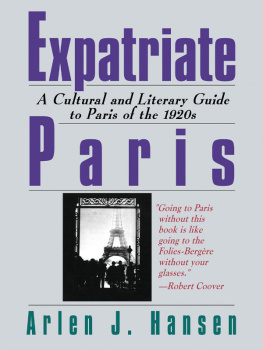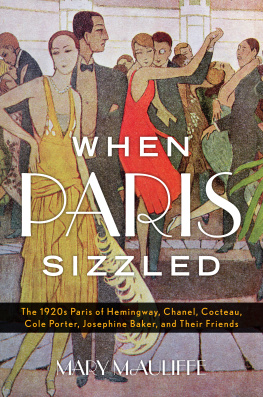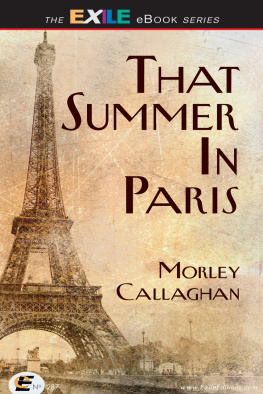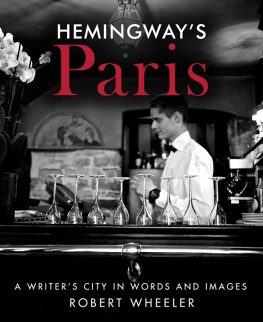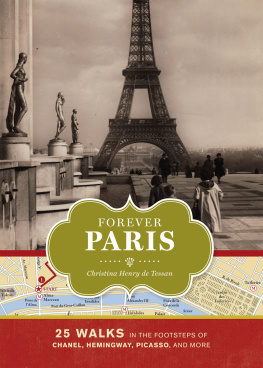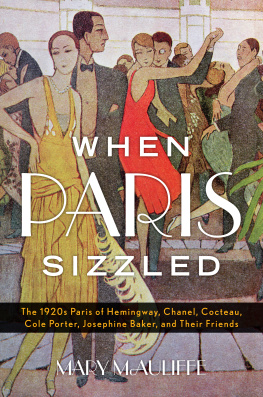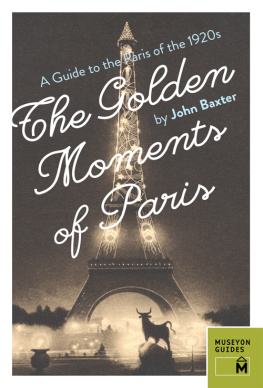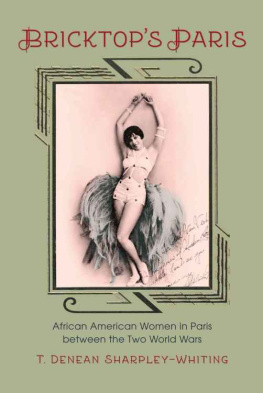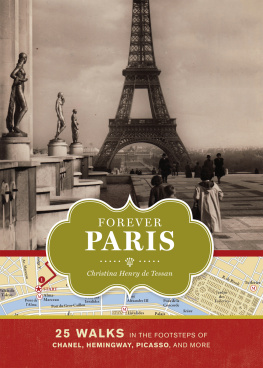
Copyright 1990, 2012 by Arlen J. Hansen
Map illustrations copyright 1990, 2012 by Richard J. Hudock
All Rights Reserved. No part of this book may be reproduced in any manner without the express written consent of the publisher, except in the case of brief excerpts in critical reviews or articles. All inquiries should be addressed to Arcade Publishing, 307 West 36th Street, 11th Floor, New York, NY 10018.
The author is grateful to Warner/Chappell Music, Inc., for permission to reprint excerpts from the following songs: Omnibus by Cole Porter 1982 Warner Bros. Inc. (renewed). All rights reserved. You Dont Know Paree by Cole Porter 1929 Warner Bros. Inc. (renewed). All rights reserved.
Excerpts from this book originally appeared in Paris Review.
Arcade Publishing books may be purchased in bulk at special discounts for sales promotion, corporate gifts, fund-raising, or educational purposes. Special editions can also be created to specifications. For details, contact the Special Sales Department, Arcade Publishing, 307 West 36th Street, 11th Floor, New York, NY 10018 or arcade@skyhorsepublishing.com.
Arcade Publishing is a registered trademark of Skyhorse Publishing, Inc., a Delaware corporation.
Visit our website at www.arcadepub.com.
10 9 8 7 6 5 4 3 2 1
Library of Congress Cataloging-in-Publication Data is available on file.
ISBN: 978-1-61145-699-8
Printed in the United States of America
For the two DLHs
the one for the first two decades,
the other for the remainder
EXPATRIATE PARIS
CONTENTS
LIST OF MAPS
23. The Gaveau and the Claridge
24. Thtre des Champs-Elyses
25. The Etoile and North to the Wagram
27. Old Embassy Area
1. The Grand Hotels
2. From the Madeleine to the Opera
3. Mostly Lost Sites: Italiens to the Louvre
5. Ile Saint-Louis
6. The Eastern Edge
11. The Odon and East
14. Place de la Contrescarpe and the Outer Fifth Arrondissement
7. Saint-Andr-des-Arts
8. From Natalie Barneys to the Htel Jacob
10. Saint-Germain and South
11. The Odon and East
12. Vaugirard and North
13. Gertrude Steins Neighborhood
15. The Primary Chamber
16. The Secondary Chamber
17. The Aorta
18. Around Montparnasse Station
19. Beyond Montparnasse
8. From Natalie Barneys to the Htel Jacob
9. The Crosbys Environs
10. Saint-Germain and South
21. The Invalides and the Eiffel
22. Around Concorde
23. The Gaveau and the Claridge
26. Porte Maillot
28. Around the Trocadro
32. Pigalle
33. Toward the Trib
Mais ce qui les sduisait, ctait cette vie de caf, de terrasse, cette libert de moeurs quils ne connaissaient ni Londres, ni dans aucune ville de la libre et austre Amrique; ctait cette kermesse internationale de La Rotonde, du Dme, du Parnasse, o lon pouvait indistinctement, et quelle que ft lheure, travailler, boire, jouer du piano, mme le dimanche, et danser mme avec des filles que lon ne connaissait pas, et qui venaient volontiers faire connaissance, pour le plaisir de voir de prs des Amricains artistes, car il ny avait point de filles vnales dans cet endroit, ou si peu vnales: du lait quand elles avaient faim, deux gouttes dalcool quand elles sennuayaient....
Michel Georges-Michel, Les Montparnos (1923)
Freely translated:
"What seduced them [the Montparnos] was the caf life and cafe-sitting, a free and open style of living that they didnt know either in London or anywhere in Puritanical America; it was an international bazaar, a county fair, a round-robin dance of the Rotonde, the Dme, the Parnasse where all hours of the day a person could indiscriminately work, drink, play the piano (on Sunday, no less), and dance even with women one didnt know, who freely offered to make ones acquaintance simply for the fun of seeing an American artist up close, or, if they werent quite so spontaneously free, then some milk for their hunger, a couple shots of liquor for their boredom....
ACKNOWLEDGMENTS
This book would not have been possible without the assistance of a great number of people and organizations: the University of the Pacific, its library staff and Faculty Research Committee; the Travel to Collections Program of the National Endowment for the Humanities; the Princeton University Library, particularly Ms. Jean Preston, Curator of Manuscripts, and her assistant Ann Van Arsdale; Professor Michel Fabre of Sorbonne III; and three gifted physicians who became my daily companions and my friends: Peter Garbeff, David White, and Prasad Dighe.
I was also blessed by the steady encouragement and support of my family and friends: Lynn, Laura, Kip, James, Tess, Eddie, Charles, John, Kate, Bob C. (juglar por excelencia), Jim B., Jeff, and hundreds more. Finally, this book benefited immeasurably from the counsel and practical wisdom of my editor, Dick Seaver, and Peggy Freudenthal, who is surely one of the finest copyeditors in captivity. Even with all this assistance and my own compulsion for perfection, however, I have probably still managed to make mistakes, oversights, and errors of judgment. For them I apologize.
How does one acknowledge a thousand sources of information? The manifold and various works where I found and confirmed facts and uncovered the details and the gossip? How does one indicate that his was the easy job, collecting the products of others labors and acknowledge that the fundamental effort belongs to those who wrote or compiled the memoirs, histories, literary studies, biographies, editions of letters that perforce precede a work like this? I suspect that true indebtedness can never be fully or properly acknowledged. I know that such a task is, sadly, beyond the limits of my ability.

INTRODUCTION
Composing lyrics for his 1929 musical, Fifty Million Frenchmen, Cole Porter came up with a verse that cautioned the casual visitor to Paris:
You come to Paris, you come to play;
You have a wonderful time, you go away.
And, from then on, you talk of Paris knowingly,
You may know Paris, you dont know Paree.
Porter knew Paree, for he himself lived on the Left Bank, and he was right about the elusive, hidden side of Paris, especially during the twenties.
In those years Paris hosted a vast assortment of transplanted artists: the hardworking young rookie Ernest Hemingway; the gregarious sculptor Constantin Brancusi; zany Tristan Tzara; the brilliant, beautiful, and brave Kay Boyle; James Joyce, an enigmatic genius; musics bad boy, George Antheil; the rebellious Andr Breton; the ebullient Josephine Baker; lanky James Thurber; timid Anas Nin....
But if expatriate life evaded the cursory tourist of the twenties, its legacy the music, poetry, paintings, and fiction is palpable today. Looking back, we can sense the unusual and rich mix that constituted Expatriate Paris: a unique period, a special place, and extraordinary people.
Only, expatriate is not the word exactly. Most of the writers, painters, sculptors, dancers, musicians, celebrities, and assorted hangers-on who are mentioned in this book were not, strictly speaking, expatriates. Only a very few might be thought of as having abandoned their native country and taken France as a new homeland. Those who did were probably Russians associated with the deposed czar, frustrated revolutionaries from any number of unsettled postwar countries, or people from other parts of Europe whose money had been fueling a skyrocketing inflation at home.
Next page
